If you are needing a keyboard lesson for beginners, you are in the right place! In this article we shall teach you, in a simple and uncomplicated way, the first steps towards you learning to play the keyboard from scratch:
1) Get to know the names of the notes and the keys
The first thing you need to do before starting to learn how to play the instrument is to learn the names of the seven musical notes: do (C), re (D), mi (E) , fa (F), sol (G), la (A) and ti (B). If you know this order by heart, then take some time to look at where they are on the instrument. Notice how each of these notes is on a white key.
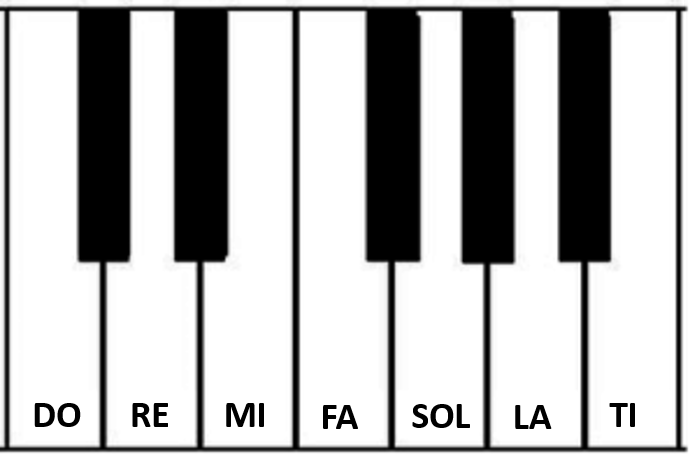
The other keys of the instrument shall be taken up by the same 7 notes. The only difference is that this group of 7 shall repeat itself, in different octaves going from the highest-pitched to the lowest-pitched notes:

The black notes on the keyboard
The notes can also be played with alterations. In other words, we can add a semitone or remove a semitone from them. When we remove a semitone, the note is then considered flat and, when a semitone is added, the note is known as sharp.
The symbols used for these alterations are: ♭, in the case of flat, and ♯, in the case of sharp. On the keyboard, we shall give names to five flat and sharp combinations:
Do♯ or Re♭ (C♯ or D♭)
Re# or Mi♭ (D# or E♭)
Fa# or Sol♭ (F# or G♭)
Sol# or La♭ (F# or A♭)
La# or Si♭ (A# or B♭)
These five changes, as above, are nothing else than the black notes of the instrument:
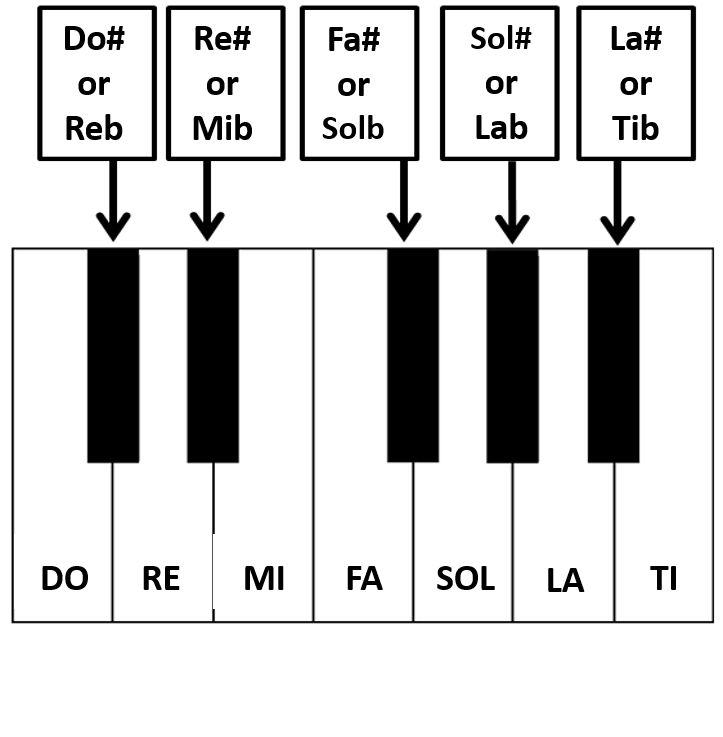
2) Learn how to quickly find the notes on the keyboard
To quickly find the notes on the keyboard, you need to look at the keyboard and quickly make out these two groups:

The idea is actually quite simple. In Group 1 we have two black notes while in Group 2 we have three.
The note that shall always be under the first black note in Group 1 is Do (C), and under Group 2 it is Fa (F).
If you learn this simple information by heart, it will be easier for you to find the other notes. For example, if you want to find mi, you just need to count two white keys after do. If you want to find sol, then this shall be one white key after fa.
Another way of memorising the location of the notes is through songs. The following lesson is a good example of how this can be done in practice:
3) Bring the notes together in chords and play your first songs
Most songs consist of chords. In other words, a certain set of notes, when played at the same time. The basic chords are represented by chord letters. These chord letters can also represent single notes, as shown in the table below:
| Name of Note | Do | Re | Mi | Fa | Sol | La | Ti |
| Chord | C | D | E | F | G | A | B |
On starting your study on the keyboard, you will need to learn how to play each of the chords. These chords can be major or minor and can come with alterations: sharps or flats.
To make learning easier, we have prepared a file showing the figures and names of all the basic chords on a keyboard. In this file, you will notice that some of the chords have a bar. This is nothing to be afraid of, as this bar is just a representation to show that the chord is in an inverted position. In other words, the notes are the same, but they shall all then start in a different order. For example, in the illustration below, we see how the chord of C major (C) starts with do in the first figure, with mi in the second, and with sol in the third:
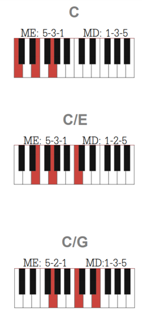
The letters “ME” and “MD”, above each chord, mean “left hand” and “right hand”, while the numbers represent the fingers that you shall need to use to play the chord using each hand. The numbering for the fingers is represented in the following manner:
How to play the keyboard: Position of hands and fingers on the keyboard
To learn how to play the keyboard, you must understand how the hand should be placed atop the keyboard. For this reason, we shall number the fingers on the right and left hands, and you will then already be able to play your first songs.
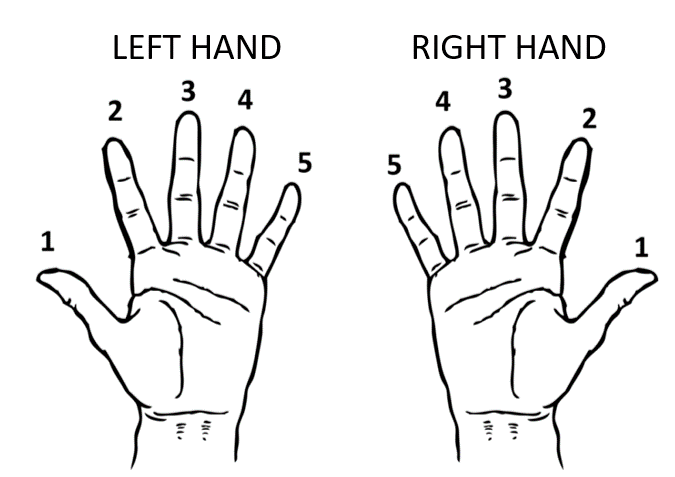
Aware of this, to play the chord of C major (C) in the left hand, you would have to use your little finger for do, the middle finger for mi and middle finger for sol (LH: 5 – 3 – 1).
Once you have grasped this basic information, you can study the file that we have made available below. Using your keyboard, try to imitate the pictures with the position of the chords on the keys. Initially, study only the first chord on each of the pages: Chords of keyboard (click here)
Even though there are many chords, most songs are made up of simple combinations. This means that you may start playing your first songs if you know only 4 or 5 chords.
You may also start to search for the songs that you like most. So we invite you to visit the AZ Chords website, choose a song, selecting the key of “C” using the icon at the top of the page. Then you just need to select “piano” (keyboard) and all the drawings of the chords shall be shown when you pass the mouse over them.
4) Practice your coordination between left and right hand
Another important study for anyone wishing to learn how to play the keyboard is the study of coordination between hands. Normally people only show motor skills with only one hand (right or left). However, for keyboard playing one must develop this skill for both hands. On many occasions, you will need to play a tune with your right hand while you play different notes or chords with your left hand. Sometimes there can even be variations in the rhythm that each of the hands can make!
For development of this technique, it is important to invest in high-quality materials. One of these materials is a book by Carl Czerny, which is widely used in thousands of music conservatories. This book brings a collection of exercises, ranging from starter levels through to really advanced levels. The exercises are for the development of coordination, speed, and passage of notes between fingers.
Please follow the keyboard lesson below if you want to start carrying out some of these exercises for coordination between the hands:
5) Decide whether you will play popular or classical piano
In the classical approach to keyboard study, you will study erudite music (mostly from the 19th Century), which can be in the form of sonatas, sonnets, operas, fugues, and symphonies. Studies in the classical area is started based on the score. The student shall be introduced to each and every one of the symbols and notations that appear on the stave, and shall then be qualified to play them on the instrument:
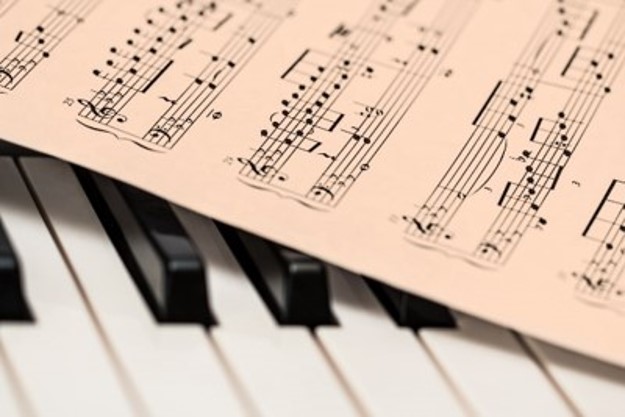
Training in the scales, such as the major and minor scales, is also common in this approach, especially for improvement of technique (speed and coordination). Other studies of the technique are also frequently sought, like those that appear in the book by Carl Czerny.
In the popular approach to study, the focus is on the chords and chord letters, rather than the score. This means that the study can start with the reading of the chord letters. In this kind of approach, it is also more common to have the exploitation of the chords of a key (chords that go well together) and harmony.
If your aim is to follow the songs played in a church or to follow a band, then this could be the most recommended approach. On playing chords rather than tunes, you give some space so that the singers and other instruments may perform the tune, you having the role of a ‘back-up element’.